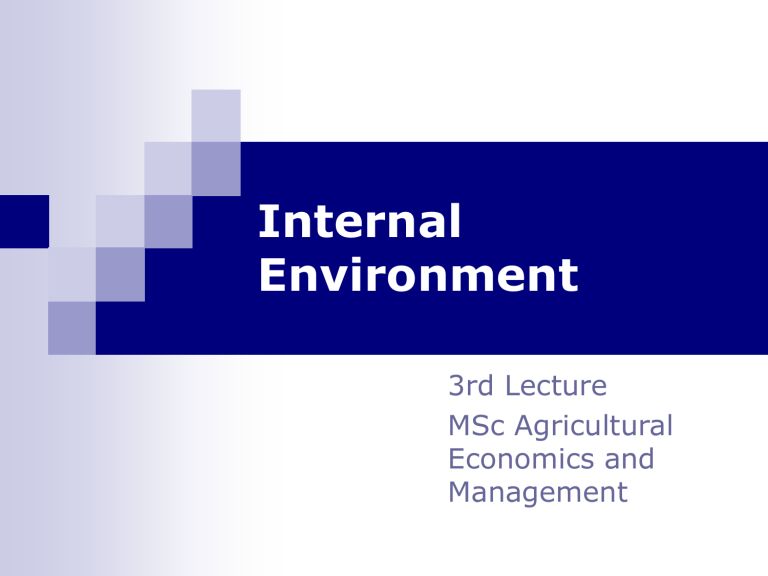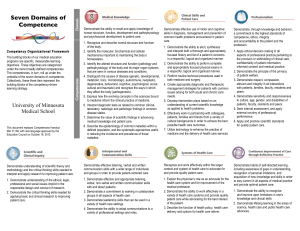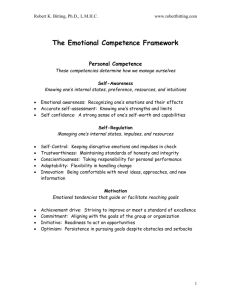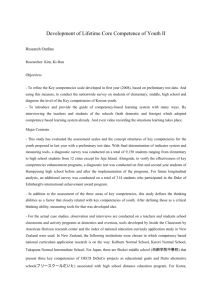Internal Environment

Internal
Environment
3rd Lecture
MSc Agricultural
Economics and
Management
External and Internal Analyses
Environment
Sociocultural
Industry
Environment
By studying the external environment, firms identify what they might choose to do
Opportunities and threats
Competitor
Environment
Technological
General
External and Internal
Analyses
By studying the internal environment, firms identify what they can do
Unique resources, capabilities, and core competencies
(sustainable competitive advantage)
Challenge of Internal Analysis
How do we effectively manage current core competencies while simultaneously developing new ones?
How do we assemble bundles of resources, capabilities and core competencies to create value for customers?
How do we learn to change rapidly?
Conditions Affecting Managerial Decisions
About Resources, Capabilities, and Core
Competencies
Uncertainty
regarding characteristics of the general and the industry environments, competitors’ actions, and customers’ preferences
Complexity
regarding the interrelated causes shaping a firm’s environments and perceptions of the environments
Intraorganizational Conflicts
among people making managerial decisions and those affected by them
Choosing the right tools for internal analysis
Start with simple techniques
Consider all tools and identify those likely to be useful
Define the competitive capabilities the enterprise needs
Identify the subsystems which support these capabilities
Identify core competence relative to competitive capabilities
Determine changes to enhance/improve core competence
Take a systemic view
Adjust the methods of analysis in the light of what is found
Some commonly used techniques for internal analysis
Single Businesses
Resource Audit
Analysis of cost and profit
Benchmarking
Value Chain Analysis
Supply Chain Analysis
Multiple Businesses
Portfolio Analysis
Both Single and Multiple Businesses
Core Competencies
Shareholder Value Analysis
Resource Audit
Resources
Physical
Human
Financial
Other
Quality and Quantity
Unique resources
A good initial analysis
Internal Audit
Parallels process of external audit
Information from:
Management
Marketing
Finance/accounting
Production/operations
Research & Development
Management information Systems
Marketing
Marketing Functions
Customer analysis
Selling products/services
Product & service planning
Pricing
Distribution
Marketing research
Opportunity analysis
Finance/Accounting
Finance/Accounting Functions
Investment decision (Capital budgeting)
Financing decision
Dividend decision
Production/Operations
Production/Operations Functions
Process
Capacity
Inventory
Workforce
Quality
Research & Development
Research & Development Functions
Development of new products before competitors
Improving product quality
Improving manufacturing processes to reduce costs
Management Information
Systems
Information Systems
Security
User-friendly
E-commerce
Analysis of Costs and Profit
Current sources of profits and trends
Recast standard reporting to give new insights
Pragmatic approach to get value from time and effort spent
A good initial analysis
Single Businesses
Resource Audit
Analysis of cost and profit
Benchmarking
Value Chain Analysis
Supply Chain Analysis
Benchmarking
Objective comparison with best in class
Simple in theory - Hard in practice
Observed differences in performance may be due to differences in parameters
Qualitative observations may be more valuable than quantitative
Benchmarking - at three levels
Level of benchmarking
Resources
Competences in separate activities
Through
Resource audit
Analysing activities
Competences through managing linkages
Analysing overall performance
Examples of measures
Quantity of resources, e.g.
· revenue/employee
· capital intensity
Quality of resources, e.g.
· qualifications of employees
·
· age of machinery uniqueness (e.g.
patents)
Sales calls/sales person
Output/ employee
Materials wastage
Market share
Profitability
Productivity
Value Chain Analysis
Basic Value chain
Elegant in theory
Time-consuming in practice
Revised value chain to reflect power of people and knowledge
Value Creation
The Basic
Value Chain
Service
Marketing & Sales
Outbound Logistics
Operations
Inbound Logistics
Primary Activities
To capitalize on the usefulness of the
Value Chain concept...
it is important to recognize that...
Value Chains are part of a Total Value System
Supplier Value Chain Firm Value Chain Channel Value Chain Buyer Value Chain
Value Chains are part of a Total Value System
Firm Value Chain Channel Value Chain Buyer Value Chain
Supplier Value Chain
Upstream Value
Perform valuable activities that complement the firm’s activities
Value Chains are part of a Total Value System
Supplier Value Chain Firm Value Chain Buyer Value Chain
Upstream
Value
Perform valuable activities that complement the firm’s activities
Channel Value Chain
Each firm must eventually find a way to become a part of some buyer’s value chain
Value Chains are part of a Total Value System
Supplier Value Chain Firm Value Chain Channel Value Chain
Upstream Value
Perform valuable activities that complement the firm’s activities
Each firm must eventually find a way to become a part of some buyer’s value chain
Buyer Value Chain
Ultimate basis for differentiation is the ability to play a role in a buyer’s value chain
This creates VALUE!!
Value Chains are part of a Total Value System
Supplier Value Chain Firm Value Chain Channel Value Chain Buyer Value Chain
Upstream
Value
Perform valuable activities
that complement the firm’s activities
Each firm must eventually find a way to become a part of some buyer’s value chain
Ultimate basis for differentiation is the ability to play a role in a buyer’s value chain
This creates VALUE!!
Value chains vary for firms in an industry, reflecting each firm’s unique qualities:
• History
• Strategy
• Success at Implementation
Outsourcing
Outsourcing is the purchase of some or all of a valuecreating activity from an external supplier
Usually this is because the specialty supplier can provide these functions more efficiently
Service
Marketing & Sales
Outbound Logistics
Operations
Inbound Logistics
Primary Activities
Strategic Rationales for
Outsourcing
Improve Business Focus
lets company focus on broader business issues by having outside experts handle various operational details
Provide Access to World-Class Capabilities
the specialized resources of outsourcing providers makes world-class capabilities available to firms in a wide range of applications
Strategic Rationales for
Outsourcing
Accelerate Business Re-Engineering Benefits
achieves re-engineering benefits more quickly by having outsiders--who have already achieved world-class standards--take over process
Share Risks
reduces investment requirements and makes firm more flexible, dynamic and better able to adapt to changing opportunities
Strategic Rationales for
Outsourcing
Free Resources for Other Purposes
permits firm to redirect efforts from non-core activities toward those that serve customers more effectively
Outsourcing Issues
Greatest Value
outsource only to firms possessing a core competence in terms of performing the primary or support activity being outsourced
Evaluating Resources and Capabilities
don’t outsource activities in which the firm itself can create and capture value
Environmental Threats and Ongoing Tasks
do not outsource primary and support activities that are used to neutralize environmental threats or complete necessary ongoing organizational tasks
Outsourcing Issues
Nonstrategic Team of Resources
do not outsource capabilities that are critical to their success, even though the capabilities are not actual sources of competitive advantage
Firm’s Knowledge Base
do not outsource activities that stimulate the development of new capabilities and competencies
Revised Value Chain
SUPPORT
ACTIVITIES
Firm’s infrastructure
Technology trapping and commercialisation
Strategic Management
PRIMARY
ACTIVITIES
INFORMATION SYSTEMS & KNOWLEDGE MANAGEMENT basic skills, know-how, technologies strategic assets core competence technical, management, marketing, sales, production price, place, promotion product service customer satisfaction, loyalty
HUMAN RESOURCE MANAGEMENT
PROCUREMENT AND SUPPLIER MANAGEMENT revenue, profit, market share,
Product portfolio matrices
RELATIVE MARKET SHARE
High Low
MARKET
GROWTH
High
Low
Stars
Cash cows
Question marks
Dogs
High
INDUSTRY
ATTRACTIVENESS
Med
Low
COMPETITIVE POSITION
Strong Average Weak
(a) The original Boston Consulting
Group Matrix (BCG)
(b) Attractiveness matrix*
Product portfolio matrices
Development
STAGE OF
PRODUCT/
COMPETITIVE POSITION
Strong Average Weak
Growth
MARKET
EVOLUTION Shake-out
Maturity
High
PUBLIC NEED
AND
Publicsector star
SUPPORT +
FUNDING
ATTRACTIVENESS
Golden fleece
Low
High
Decline
Political hot box
Back drawer issue
Low
ABILITY TO SERVE
EFFECTIVELY
(c) Product/market evolution matrix (d) Public sector portfolio matrix
Portfolio Analyses
Over-coming some pitfalls:
Defining `high’ and `low’ (growth or share) can be difficult
`Plot’ SBU’s not products
Apply to market segments not whole markets
Assess the `role’ of each SBU
Consider wider resource implications - not just cash
Dogs may have a positive role
Components of
Internal Analysis
Discovering Core
Competencies
Core
Competencies
Capabilities
Resources
Tangible
Intangible
Four Criteria of Sustainable
Advantages
• Valuable
• Rare
• Costly to Imitate
• Nonsubstitutable
Value Creation
Competitive
Advantage
Value
Chain
Analysis
• Outsource
Resources, Capabilities and Core
Competencies
Capabilities
Are the firm’s capacity to deploy resources that have been purposely integrated to achieve a desired end state
Emerge over time through complex interactions among tangible and intangible resources
Often are based on developing, carrying and exchanging information and knowledge through the firm’s human capital
Resources, Capabilities and Core
Competencies
Capabilities
The foundation of many capabilities lies in:
The unique skills and knowledge of a firm’s employees
The functional expertise of those employees
Capabilities are often developed in specific functional areas or as part of a functional area
Resources, Capabilities and Core
Competencies
Core Competencies
Resources and capabilities that serve as a source of a firm’s competitive advantage:
Distinguish a company competitively and reflect its personality
Emerge over time through an organizational process of accumulating and learning how to deploy different resources and capabilities
Resources, Capabilities and Core
Competencies
Core Competencies
Activities that a firm performs especially well compared to competitors
Activities through which the firm adds unique value to its goods or services over a long period of time
Building Sustainable Competitive
Advantage
Four Criteria of
Sustainable Competitive
Advantage
Valuable
Rare
Costly to imitate
Nonsubstituable
Building Sustainable Competitive
Advantage
Valuable capabilities
Help a firm neutralize threats or exploit opportunities
Rare capabilities
Are not possessed by many others
Building Sustainable Competitive
Advantage
Costly-to-Imitate
Capabilities
Historical
A unique and a valuable organizational culture or brand name
Ambiguous cause
The causes and uses of a competence are unclear
Social complexity
Interpersonal relationships, trust, and friendship among managers, suppliers, and customers
Building Sustainable Competitive
Advantage
Nonsubstitutable Capabilities
No strategic equivalent
Core Competence as a Strategic
Capability
Resources
Inputs to a firm’s production process
Core Competence
A strategic capability
The source of
Capability
An integration of a team of resources
Does it satisfy the criteria of sustainable competitive advantage?
Yes
No
Capability
A nonstrategic team or resource
Sustainability of Competitive Advantage
Sustainability of competitive advantage is a function of:
the rate of core-competence obsolescence due to environmental changes
the availability of substitutes for the core competence
the imitability of the core competence
Performance Implications
No No No No
Yes No No
Yes/
No
Yes Yes No
Yes/
No
Yes Yes Yes Yes
Competitive
Consequences
Competitive
Disadvantage
Competitive
Parity
Performance
Implications
Below Average
Returns
Average Returns
Temporary Competitive Advantage
Above Average to
Average Returns
Sustainable Competitive Advantage
Above Average
Returns
Core Competencies:
Cautions and Reminders
Never take for granted that core competencies will continue to provide a source of competitive advantage
All core competencies have the potential to become core rigidities
Core rigidities are former core competencies that now generate inertia and stifle innovation
The SWOT diagram may summarise the results of analyses
Strengths Weaknesses
Internal
Analyses
Threats Opportunities
External
Analyses
Strategic Assessment of a business as a whole
Questions
What business are we really in?
What real customer needs do we satisfy?
What problem do we solve for our customers?






